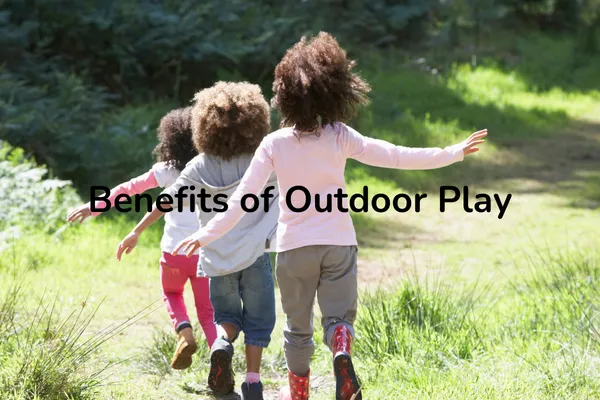
Why Outdoor Play Could Be the Secret to Better Sleep for Your Child

🌿 Why Outdoor Play Could Be the Secret to Better Sleep for Your Child
Sleep — it’s the golden ticket to calmer evenings, focused school days, and a more balanced household. But if bedtime battles, restless nights, or early wake-ups are taking over your evenings, one powerful (and often overlooked) solution might be right outside your front door: outdoor play.
In this blog, we’ll explore how regular time outdoors can support healthy sleep in children aged 3–10 (and yes — it works wonders for toddlers too!).I'll also introduce our brand-new free guide: 5 Goals for Optimal Sleep – Kids Edition — a practical roadmap for families seeking better rest.
☀️ The Science Behind Outdoor Play & Sleep
When kids run, climb, scooter, or even dig in the garden, they’re doing much more than burning energy. Outdoor play activates a number of biological processes that help prepare the body and brain for high-quality sleep:
1. Light Regulates the Sleep-Wake Cycle
Natural daylight — especially in the morning — helps set your child’s circadian rhythm. That’s their internal clock that regulates when they feel sleepy or awake. The hormone melatonin (aka the “sleep hormone”) is influenced by light. When children get enough exposure to daylight, their bodies naturally produce melatonin in the evening — making it easier to fall asleep.
2. Movement Lowers Cortisol
Cortisol is the body’s stress hormone, and chronically elevated levels can lead to poor sleep. Outdoor movement helps reduce cortisol and increase calming neurotransmitters like serotonin. This is particularly useful for children dealing with anxiety, overstimulation, or big transitions (like starting school).
3. Physical Play Builds Sleep Pressure
Sleep pressure is your body’s internal drive to sleep. Active children build sleep pressure throughout the day, meaning they’re more ready for bed when night time comes. If your child has trouble winding down, struggles with bedtime delay tactics, or seems “wired but tired,” they may not be getting enough physical activity.
💡 Real Life Example
A family I recently worked with had two boys — ages 5 and 8 — who were bouncing off the walls until 10pm most nights. Screens were limited, routines were consistent, but nothing seemed to settle them. Together, we added a 30-minute outdoor “adventure walk” after dinner: no tech, just scooters and imagination.
Within a week, bedtime was earlier, easier, and without fuss. One simple habit made all the difference.
"We couldn’t believe how fast things changed! That extra energy release and daylight worked wonders — Kath’s support was a game changer."
– Sleep support client, mum of two
👪 Who Benefits Most?
All kids benefit from outdoor play — but especially:
Toddlers and preschoolers (1–4 yrs): Helps improve naps and release pent-up energy.
Primary-aged children (5–10 yrs): Builds independence and reduces screen dependency, while promoting wind-down readiness.
Sensitive or anxious children: Outdoor sensory input is grounding and can reduce sleep resistance caused by worry or restlessness.
🧩 Simple Ways to Add Outdoor Time to Your Routine
You don’t need to overhaul your whole day to get the benefits. Here are some family-friendly ways to increase outdoor time:
Walk or scoot to/from school (even part of the way)
Nature scavenger hunts (great for weekends!)
Post-dinner play: bubbles, ball games, chalk art
Outdoor chores: watering plants, raking leaves, collecting sticks
Picnic homework sessions after school — change of scene = win!
Even 20–30 minutes of unstructured outdoor play can be enough to support healthy sleep patterns.
🛋️ What About Cold or Rainy Days?
Dress appropriately and get out anyway (Scandi parents swear by this!). But if outdoor play really isn’t an option, mimic the benefits indoors:
Jumping on a mini trampoline
Yoga or freeze dance games
Sensory bins or pretend play in front of a bright window
🎯 What Else Can Help?
Outdoor play is just one part of the bigger sleep picture. That’s why I created my free downloadable guide:
"5 Goals for Optimal Sleep – Kids Edition."
Inside, you’ll learn:
How to build a routine that works for your family
The sleep science behind why kids resist bedtime
Real strategies for anxiety, screen struggles, and sibling dynamics
📥 Ready to take the next step?
You don’t have to overhaul everything. Just one small shift — like a park visit or school walk — can make sleep smoother for everyone.
✨ Want the full sleep picture?
📩 Download the free guide here: 5 Goals for Optimal Sleep – Kids Edition
Or, if you’re on Instagram — comment the word "GUIDE" and I’ll send it straight to your inbox!
You’ve got this — and I’m here if you need support along the way. 🧡